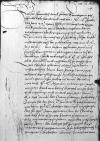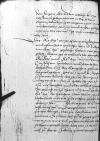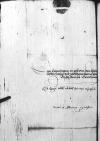List #4988
Albrecht I von Hohenzollern-Ansbach do Ioannes DANTISCUSKönigsberg (Królewiec), 1540-03-25
| odebrano Guttstadt (Dobre Miasto), 1540-03-27 Rękopiśmienne podstawy źródłowe:
Pomocnicze podstawy źródłowe:
Publikacje:
| ||||||||||
Tekst + aparat krytyczny + komentarzZwykły tekstTekst + komentarzTekst + aparat krytyczny
Dem erwirdigenn in Goth unnserm besondernn hidden by binding⌈[rnn]rnn hidden by binding⌉ lieben freunt und nachbarnn, herrnn
Unnser freuntlich dinnst zuvorn.
Erwirdiger in Goth, besunder lieber freundt unnd nachtbar.
E(uer) L(ieb) cf.  BCz, 1606, p. 388 denn dingenn ader andern welliche
BCz, 1606, p. 388 denn dingenn ader andern welliche
Das ko(nigliche) ma(ieste)t unnser aller gnedigster herr vetter hidden by binding⌈[etter]etter hidden by binding⌉ unnd ohaim irenn gesanthen denn n(obilem)(?)
Bittenn Got er wolle als der eÿnigk geist hidden by binding⌈[ist]ist hidden by binding⌉ Ro(misch) key(serliche)r unnd ko(nigliche)r ma(ieste)t auch andernn hohen hidden by binding⌈[hen]hen hidden by binding⌉ cristlichenn haupternn unnd potentatenn, / dergleichenn auch / dem koniglichenn gesantenn die gnad gebenn, / das auf unnd in itziger zusammenkunfft des geschlossenn unnd ausgerichtet, / das zu Gottes ehr, / fried, / rhu, / lieb, / eynigkeit unnd aller wolfarth diene[...] hidden by binding⌈[...][...] hidden by binding⌉ der gesanthe auch zu ehrenn, nutz unnd bestenn
Unnd wiewol E(uer) L(ieb) durch diesen konig(liche)r ma(ieste)t(en) unnd vorgefallenn mittell zur rhue kumpt, / das wir derselbenn woll gunnenn, / so sollenn doch E(uer) L(ieb) gewis gleub[...] hidden by binding⌈[...][...] hidden by binding⌉, wo es ann unns und unserm einfeltigen bede[...] hidden by binding⌈[...][...] hidden by binding⌉ gelegenn gewest wher, / das wir, / so es auch noch zu ferner schickung queme vorigenn  BCz, 1606, p. 389 unnsernn erwegungenn unnd ratschlegen nach, des wir E(uer) L(ieb) wissenn gerathen habenn woltenn, / so unnsers vorhoffens ko(nigliche)r ma(ieste)t(en) der loblichenn
BCz, 1606, p. 389 unnsernn erwegungenn unnd ratschlegen nach, des wir E(uer) L(ieb) wissenn gerathen habenn woltenn, / so unnsers vorhoffens ko(nigliche)r ma(ieste)t(en) der loblichenn
Das alles wir E(uer) L(ieb) auf ir cf.
Dat(um)
Von Gots gnadenn



